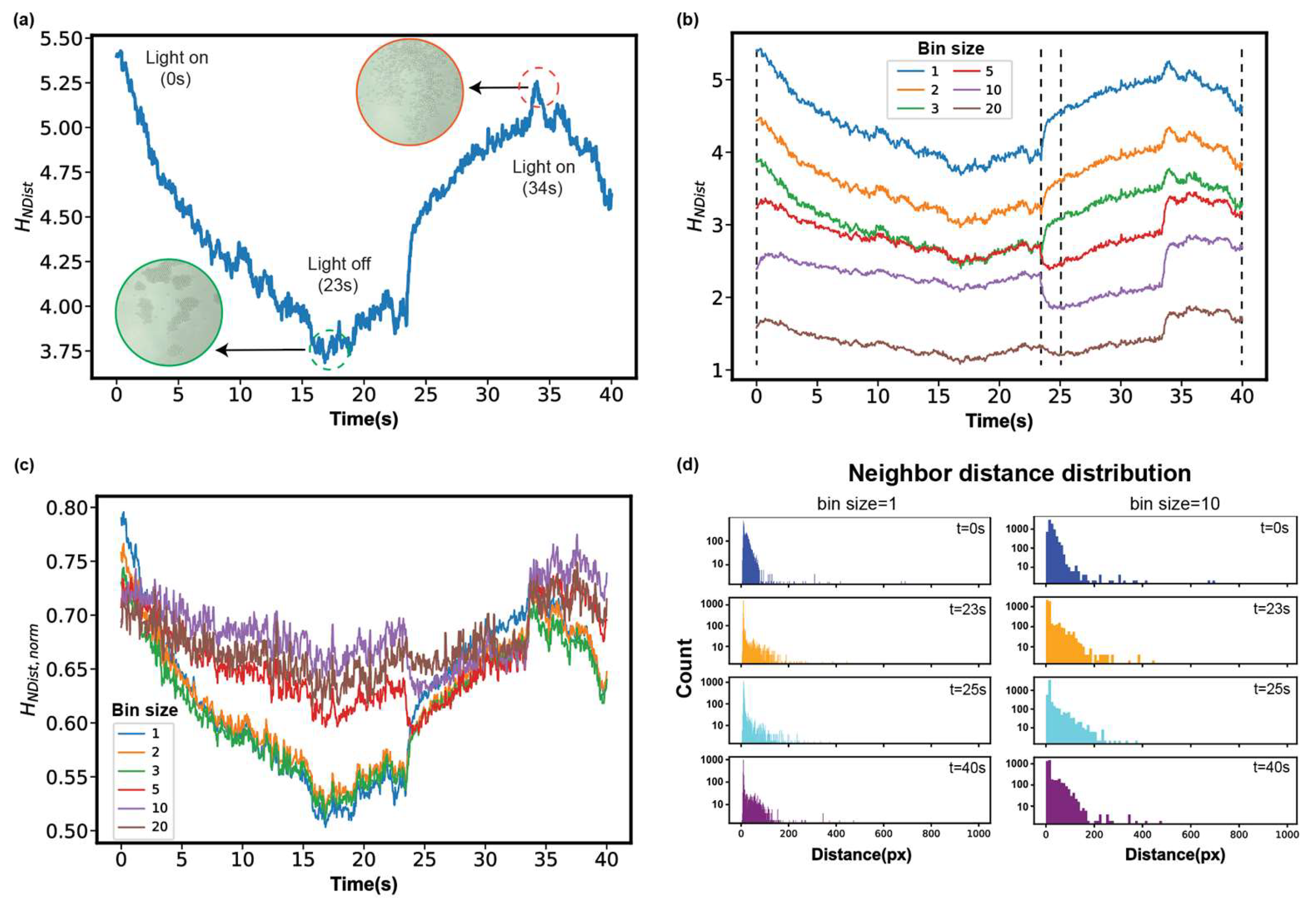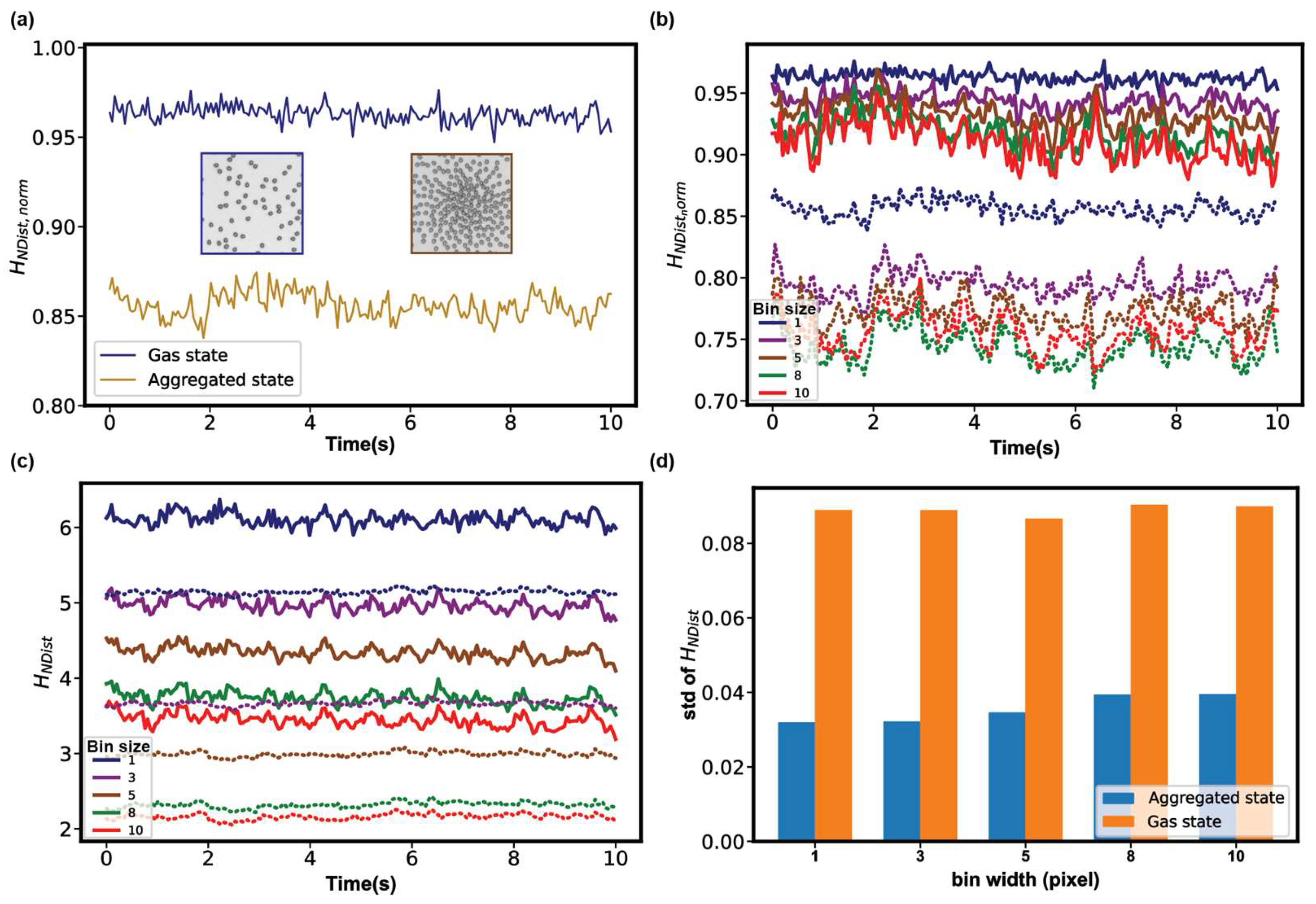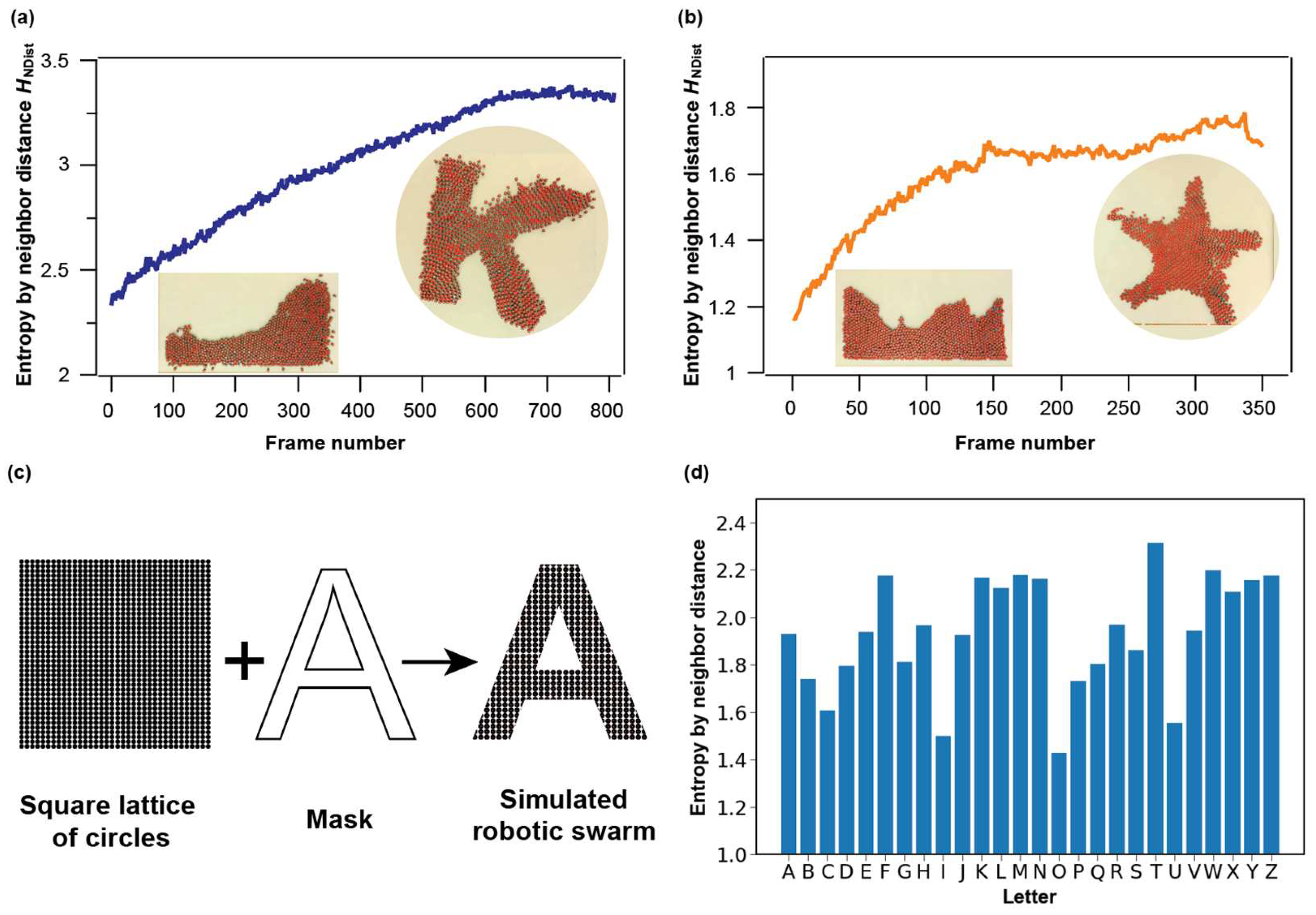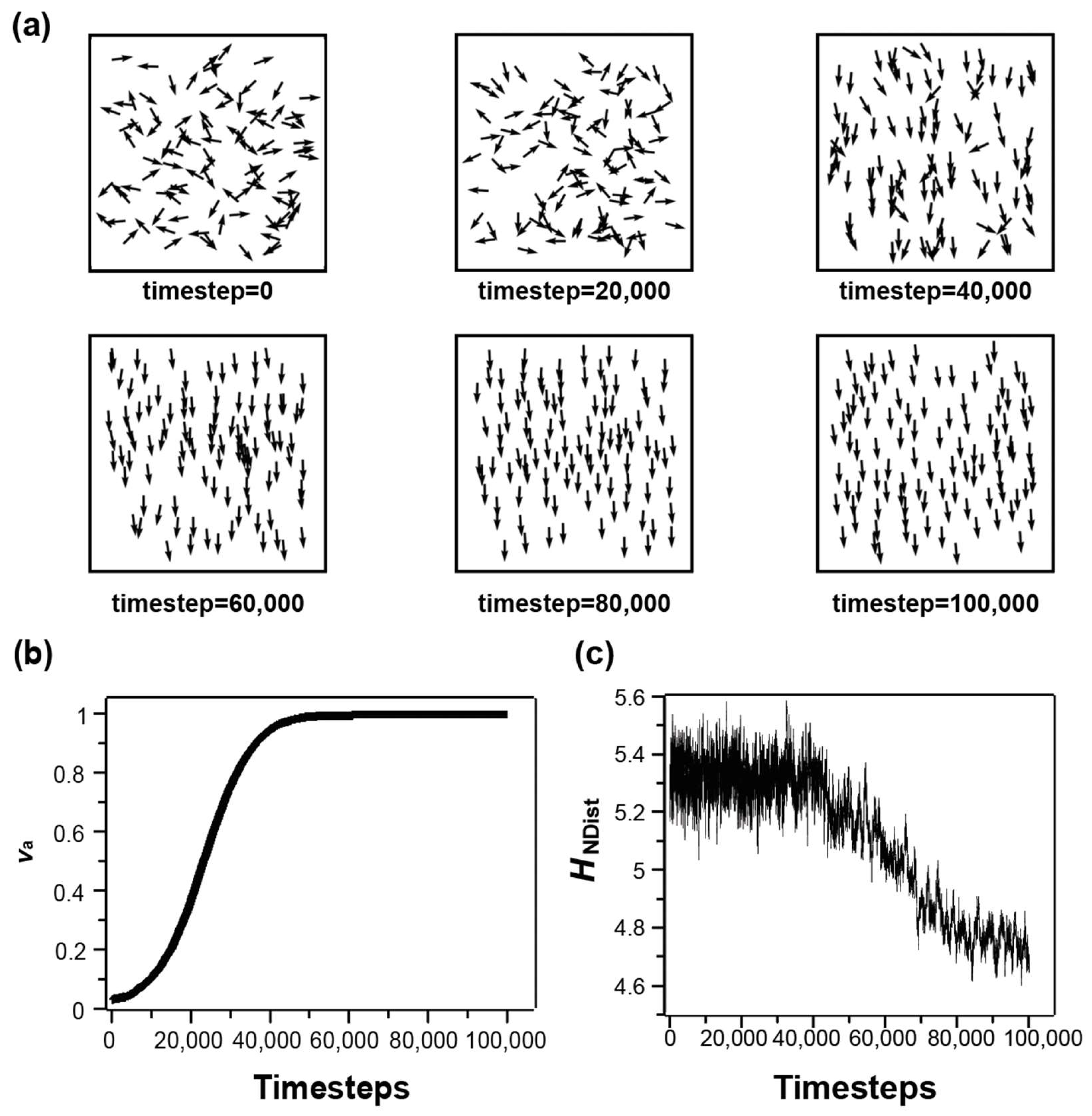Entropy by Neighbor Distance as a New Measure for Characterizing Spatiotemporal Orders in Microscopic Collective Systems
Abstract
1. Introduction
2. Results and Discussion
2.1. Simulated Boid System
2.2. Active Colloids


2.3. Robotic Swarm

3. Conclusions and Discussion
4. Methods
4.1. Boids Simulation
- ➢
- Algorithm
- ➢
- Definition of neighbors who has mutual interaction
4.2. Data Analysis
- ➢
- Calculation of average velocity
- ➢
- Calculation of Entropy by neighbor distance
- ➢
- Particle tracking
Supplementary Materials
Author Contributions
Funding
Data Availability Statement
Acknowledgments
Conflicts of Interest
References
- Bowick, M.J.; Fakhri, N.; Marchetti, M.C.; Ramaswamy, S. Symmetry, Thermodynamics, and Topology in Active Matter. Phys. Rev. X 2022, 12, 010501. [Google Scholar] [CrossRef]
- Marchetti, M.C.; Joanny, J.F.; Ramaswamy, S.; Liverpool, T.B.; Prost, J.; Rao, M.; Simha, R.A. Hydrodynamics of Soft Active Matter. Rev. Mod. Phys. 2013, 85, 1143–1189. [Google Scholar] [CrossRef]
- Lauga, E. Life around the Scallop Theorem. Soft Matter 2011, 7, 3060–3065. [Google Scholar] [CrossRef]
- Battle, C.; Broedersz, C.P.; Fakhri, N.; Geyer, V.F.; Howard, J.; Schmidt, C.F.; MacKintosh, F.C. Broken Detailed Balance at Mesoscopic Scales in Active Biological Systems. Science 2016, 352, 604–607. [Google Scholar] [CrossRef] [PubMed]
- Vicsek, T.; Zafeiris, A. Collective Motion. Phys. Rep. 2012, 517, 71–140. [Google Scholar] [CrossRef]
- Makris, N.C.; Ratilal, P.; Symonds, D.T.; Jagannathan, S.; Lee, S.; Nero, R.W. Fish Population and Behavior Revealed by Instantaneous Continental Shelf-Scale Imaging. Science 2006, 311, 660–663. [Google Scholar] [CrossRef]
- Anderson, C.; Fernandez-Nieves, A. Social Interactions Lead to Motility-Induced Phase Separation in Fire Ants. Nat. Commun. 2022, 13, 6710. [Google Scholar] [CrossRef]
- Worlitzer, V.M.; Jose, A.; Grinberg, I.; Bär, M.; Heidenreich, S.; Eldar, A.; Ariel, G.; Be’er, A. Biophysical Aspects Underlying the Swarm to Biofilm Transition. Sci. Adv. 2022, 8, eabn8152. [Google Scholar] [CrossRef]
- Zhang, H.P.; Be’er, A.; Florin, E.-L.; Swinney, H.L. Collective Motion and Density Fluctuations in Bacterial Colonies. Proc. Natl. Acad. Sci. USA 2010, 107, 13626–13630. [Google Scholar] [CrossRef]
- Yu, J.; Wang, B.; Du, X.; Wang, Q.; Zhang, L. Ultra-Extensible Ribbon-like Magnetic Microswarm. Nat. Commun. 2018, 9, 3260. [Google Scholar] [CrossRef]
- Zheng, J.; Chen, J.; Jin, Y.; Wen, Y.; Mu, Y.; Wu, C.; Wang, Y.; Tong, P.; Li, Z.; Hou, X.; et al. Photochromism from Wavelength-Selective Colloidal Phase Segregation. Nature 2023, 617, 499–506. [Google Scholar] [CrossRef]
- Bricard, A.; Caussin, J.-B.; Desreumaux, N.; Dauchot, O.; Bartolo, D. Emergence of Macroscopic Directed Motion in Populations of Motile Colloids. Nature 2013, 503, 95–98. [Google Scholar] [CrossRef]
- Meredith, C.H.; Castonguay, A.C.; Chiu, Y.-J.; Brooks, A.M.; Moerman, P.G.; Torab, P.; Wong, P.K.; Sen, A.; Velegol, D.; Zarzar, L.D. Chemical Design of Self-Propelled Janus Droplets. Matter 2022, 5, 616–633. [Google Scholar] [CrossRef]
- Che, S.; Zhang, J.; Mou, F.; Guo, X.; Kauffman, J.E.; Sen, A.; Guan, J. Light-Programmable Assemblies of Isotropic Micromotors. Research 2022, 2022, 9816562. [Google Scholar] [CrossRef]
- Li, L.; Yu, Z.; Liu, J.; Yang, M.; Shi, G.; Feng, Z.; Luo, W.; Ma, H.; Guan, J.; Mou, F. Swarming Responsive Photonic Nanorobots for Motile-Targeting Microenvironmental Mapping and Mapping-Guided Photothermal Treatment. Nano-Micro Lett. 2023, 15, 141. [Google Scholar] [CrossRef]
- Mou, F.; Zhang, J.; Wu, Z.; Du, S.; Zhang, Z.; Xu, L.; Guan, J. Phototactic Flocking of Photochemical Micromotors. iScience 2019, 19, 415–424. [Google Scholar] [CrossRef] [PubMed]
- Mou, F.; Li, X.; Xie, Q.; Zhang, J.; Xiong, K.; Xu, L.; Guan, J. Active Micromotor Systems Built from Passive Particles with Biomimetic Predator–Prey Interactions. ACS Nano 2020, 14, 406–414. [Google Scholar] [CrossRef] [PubMed]
- Harada, Y.; Noguchi, A.; Kishino, A.; Yanagida, T. Sliding Movement of Single Actin Filaments on One-Headed Myosin Filaments. Nature 1987, 326, 805–808. [Google Scholar] [CrossRef]
- Badoual, M.; Jülicher, F.; Prost, J. Bidirectional Cooperative Motion of Molecular Motors. Proc. Natl. Acad. Sci. USA 2002, 99, 6696–6701. [Google Scholar] [CrossRef] [PubMed]
- Vicsek, T.; Czirók, A.; Ben-Jacob, E.; Cohen, I.; Shochet, O. Novel Type of Phase Transition in a System of Self-Driven Particles. Phys. Rev. Lett. 1995, 75, 1226–1229. [Google Scholar] [CrossRef] [PubMed]
- Schrödinger, E. What Is Life? Cambridge University Press: Cambridge, UK, 1944; ISBN 978-1-107-60466-7. [Google Scholar]
- Martiniani, S.; Chaikin, P.M.; Levine, D. Quantifying Hidden Order out of Equilibrium. Phys. Rev. X 2019, 9, 011031. [Google Scholar] [CrossRef]
- Cartwright, J.H.E.; Mackay, A.L. Beyond Crystals: The Dialectic of Materials and Information. Phil. Trans. R. Soc. A 2012, 370, 2807–2822. [Google Scholar] [CrossRef] [PubMed][Green Version]
- Frenkel, M.; Fedorets, A.A.; Dombrovsky, L.A.; Nosonovsky, M.; Legchenkova, I.; Bormashenko, E. Continuous Symmetry Measure vs Voronoi Entropy of Droplet Clusters. J. Phys. Chem. C 2021, 125, 2431–2436. [Google Scholar] [CrossRef]
- Krivovichev, S. Topological Complexity of Crystal Structures: Quantitative Approach. Acta Cryst A 2012, 68, 393–398. [Google Scholar] [CrossRef] [PubMed]
- Krivovichev, S.V. Which Inorganic Structures Are the Most Complex? Angew. Chem. Int. Ed. 2014, 53, 654–661. [Google Scholar] [CrossRef] [PubMed]
- Varn, D.P.; Crutchfield, J.P. Chaotic Crystallography: How the Physics of Information Reveals Structural Order in Materials. Curr. Opin. Chem. Eng. 2015, 7, 47–56. [Google Scholar] [CrossRef]
- Wang, W.; Gardi, G.; Malgaretti, P.; Kishore, V.; Koens, L.; Son, D.; Gilbert, H.; Wu, Z.; Harwani, P.; Lauga, E.; et al. Order and Information in the Patterns of Spinning Magnetic Micro-Disks at the Air-Water Interface. Sci. Adv. 2022, 8, eabk0685. [Google Scholar] [CrossRef] [PubMed]
- Reynolds, C.W. Flocks, Herds and Schools: A Distributed Behavioral Model. SIGGRAPH Comput. Graph. 1987, 21, 25–34. [Google Scholar] [CrossRef]
- Bär, M.; Großmann, R.; Heidenreich, S.; Peruani, F. Self-Propelled Rods: Insights and Perspectives for Active Matter. Annu. Rev. Condens. Matter Phys. 2020, 11, 441–466. [Google Scholar] [CrossRef]
- Pan, Q.; He, Y. Recent Advances in Self-Propelled Particles. Sci. China Chem. 2017, 60, 1293–1304. [Google Scholar] [CrossRef]
- Wang, W.; Duan, W.; Ahmed, S.; Sen, A.; Mallouk, T.E. From One to Many: Dynamic Assembly and Collective Behavior of Self-Propelled Colloidal Motors. Acc. Chem. Res. 2015, 48, 1938–1946. [Google Scholar] [CrossRef]
- Chen, Y.; Chen, D.; Liang, S.; Dai, Y.; Bai, X.; Song, B.; Zhang, D.; Chen, H.; Feng, L. Recent Advances in Field-Controlled Micro–Nano Manipulations and Micro–Nano Robots. Adv. Intell. Syst. 2022, 4, 2100116. [Google Scholar] [CrossRef]
- Shields, C.W.; Velev, O.D. The Evolution of Active Particles: Toward Externally Powered Self-Propelling and Self-Reconfiguring Particle Systems. J. Chem. Prac. 2017, 3, 539–559. [Google Scholar] [CrossRef]
- Wang, Q.; Zhang, L. External Power-Driven Microrobotic Swarm: From Fundamental Understanding to Imaging-Guided Delivery. ACS Nano 2021, 15, 149–174. [Google Scholar] [CrossRef] [PubMed]
- Cates, M.E.; Tailleur, J. Motility-Induced Phase Separation. Annu. Rev. Condens. Matter Phys. 2015, 6, 219–244. [Google Scholar] [CrossRef]
- Fu, Y.; Yu, H.; Zhang, X.; Malgaretti, P.; Kishore, V.; Wang, W. Microscopic Swarms: From Active Matter Physics to Biomedical and Environmental Applications. Micromachines 2022, 13, 295. [Google Scholar] [CrossRef] [PubMed]
- Theurkauff, I.; Cottin-Bizonne, C.; Palacci, J.; Ybert, C.; Bocquet, L. Dynamic Clustering in Active Colloidal Suspensions with Chemical Signaling. Phys. Rev. Lett. 2012, 108, 268303. [Google Scholar] [CrossRef] [PubMed]
- Aziz, A.; Pane, S.; Iacovacci, V.; Koukourakis, N.; Czarske, J.; Menciassi, A.; Medina-Sánchez, M.; Schmidt, O.G. Medical Imaging of Microrobots: Toward In Vivo Applications. ACS Nano 2020, 14, 10865–10893. [Google Scholar] [CrossRef]
- Chen, H.; Zhang, H.; Xu, T.; Yu, J. An Overview of Micronanoswarms for Biomedical Applications. ACS Nano 2021, 15, 15625–15644. [Google Scholar] [CrossRef]
- Nelson, B.J.; Kaliakatsos, I.K.; Abbott, J.J. Microrobots for Minimally Invasive Medicine. Annu. Rev. Biomed. Eng. 2010, 12, 55–85. [Google Scholar] [CrossRef]
- Buttinoni, I.; Bialké, J.; Kümmel, F.; Löwen, H.; Bechinger, C.; Speck, T. Dynamical Clustering and Phase Separation in Suspensions of Self-Propelled Colloidal Particles. Phys. Rev. Lett. 2013, 110, 238301. [Google Scholar] [CrossRef] [PubMed]
- Wittkowski, R.; Tiribocchi, A.; Stenhammar, J.; Allen, R.J.; Marenduzzo, D.; Cates, M.E. Scalar Φ4 Field Theory for Active-Particle Phase Separation. Nat. Commun. 2014, 5, 4351. [Google Scholar] [CrossRef]
- Palacci, J.; Sacanna, S.; Steinberg, A.P.; Pine, D.J.; Chaikin, P.M. Living Crystals of Light-Activated Colloidal Surfers. Science 2013, 339, 936–940. [Google Scholar] [CrossRef] [PubMed]
- Zhang, B.; Sokolov, A.; Snezhko, A. Reconfigurable Emergent Patterns in Active Chiral Fluids. Nat. Commun. 2020, 11, 4401. [Google Scholar] [CrossRef] [PubMed]
- Vásárhelyi, G.; Virágh, C.; Somorjai, G.; Nepusz, T.; Eiben, A.E.; Vicsek, T. Optimized Flocking of Autonomous Drones in Confined Environments. Sci. Robot. 2018, 3, eaat3536. [Google Scholar] [CrossRef] [PubMed]
- Arnold, R.; Carey, K.; Abruzzo, B.; Korpela, C. What Is A Robot Swarm: A Definition for Swarming Robotics. In Proceedings of the 2019 IEEE 10th Annual Ubiquitous Computing, Electronics & Mobile Communication Conference (UEMCON), New York, NY, USA, 10–12 October 2019; pp. 0074–0081. [Google Scholar]
- Rubenstein, M.; Cornejo, A.; Nagpal, R. Programmable Self-Assembly in a Thousand-Robot Swarm. Science 2014, 345, 795–799. [Google Scholar] [CrossRef] [PubMed]
- Ballerini, M.; Cabibbo, N.; Candelier, R.; Cavagna, A.; Cisbani, E.; Giardina, I.; Lecomte, V.; Orlandi, A.; Parisi, G.; Procaccini, A.; et al. Interaction Ruling Animal Collective Behavior Depends on Topological Rather than Metric Distance: Evidence from a Field Study. Proc. Natl. Acad. Sci. USA 2008, 105, 1232–1237. [Google Scholar] [CrossRef]
- Wallace, D.C. Statistical Mechanical Theory of Liquid Entropy. Int. J. Quantum Chem. 1994, 52, 425–435. [Google Scholar] [CrossRef]
- Piaggi, P.M.; Parrinello, M. Entropy Based Fingerprint for Local Crystalline Order. J. Chem. Phys. 2017, 147, 114112. [Google Scholar] [CrossRef]
- Wallace, D.C. On the Role of Density Fluctuations in the Entropy of a Fluid. J. Chem. Phys. 1987, 87, 2282–2284. [Google Scholar] [CrossRef]
- Floreano, D.; Wood, R.J. Science, Technology and the Future of Small Autonomous Drones. Nature 2015, 521, 460–466. [Google Scholar] [CrossRef] [PubMed]
- Brambilla, M.; Ferrante, E.; Birattari, M.; Dorigo, M. Swarm Robotics: A Review from the Swarm Engineering Perspective. Swarm Intell. 2013, 7, 1–41. [Google Scholar] [CrossRef]
- Midtvedt, B.; Helgadottir, S.; Argun, A.; Pineda, J.; Midtvedt, D.; Volpe, G. Quantitative Digital Microscopy with Deep Learning. Appl. Phys. Rev. 2021, 8, 011310. [Google Scholar] [CrossRef]


Disclaimer/Publisher’s Note: The statements, opinions and data contained in all publications are solely those of the individual author(s) and contributor(s) and not of MDPI and/or the editor(s). MDPI and/or the editor(s) disclaim responsibility for any injury to people or property resulting from any ideas, methods, instructions or products referred to in the content. |
© 2023 by the authors. Licensee MDPI, Basel, Switzerland. This article is an open access article distributed under the terms and conditions of the Creative Commons Attribution (CC BY) license (https://creativecommons.org/licenses/by/4.0/).
Share and Cite
Fu, Y.; Wu, Z.; Zhan, S.; Yang, J.; Gardi, G.; Kishore, V.; Malgaretti, P.; Wang, W. Entropy by Neighbor Distance as a New Measure for Characterizing Spatiotemporal Orders in Microscopic Collective Systems. Micromachines 2023, 14, 1503. https://doi.org/10.3390/mi14081503
Fu Y, Wu Z, Zhan S, Yang J, Gardi G, Kishore V, Malgaretti P, Wang W. Entropy by Neighbor Distance as a New Measure for Characterizing Spatiotemporal Orders in Microscopic Collective Systems. Micromachines. 2023; 14(8):1503. https://doi.org/10.3390/mi14081503
Chicago/Turabian StyleFu, Yulei, Zongyuan Wu, Sirui Zhan, Jiacheng Yang, Gaurav Gardi, Vimal Kishore, Paolo Malgaretti, and Wendong Wang. 2023. "Entropy by Neighbor Distance as a New Measure for Characterizing Spatiotemporal Orders in Microscopic Collective Systems" Micromachines 14, no. 8: 1503. https://doi.org/10.3390/mi14081503
APA StyleFu, Y., Wu, Z., Zhan, S., Yang, J., Gardi, G., Kishore, V., Malgaretti, P., & Wang, W. (2023). Entropy by Neighbor Distance as a New Measure for Characterizing Spatiotemporal Orders in Microscopic Collective Systems. Micromachines, 14(8), 1503. https://doi.org/10.3390/mi14081503





